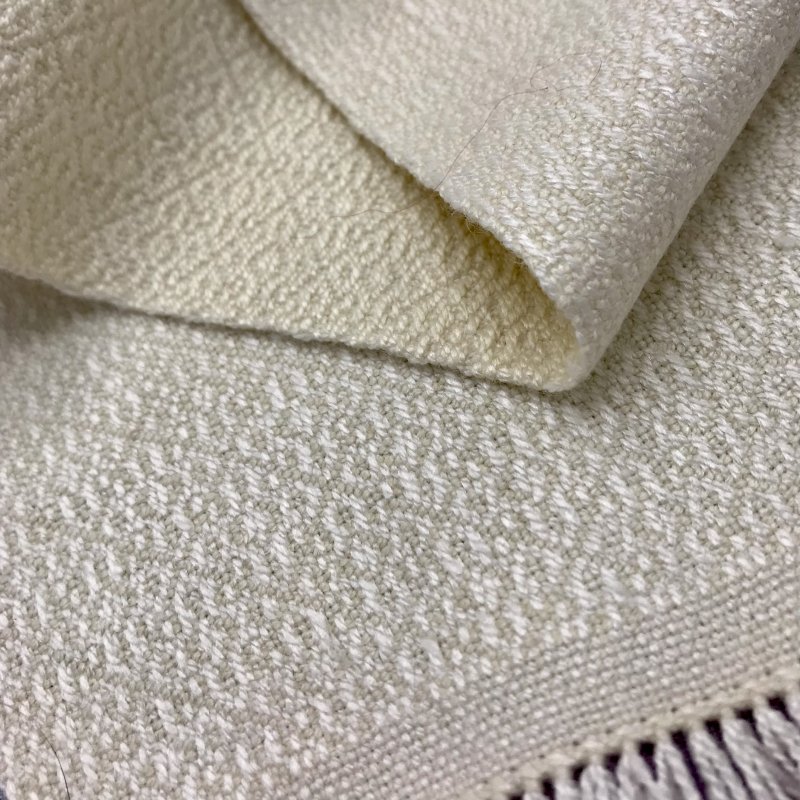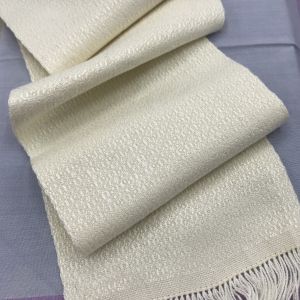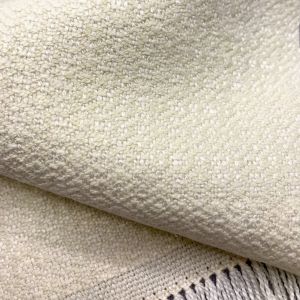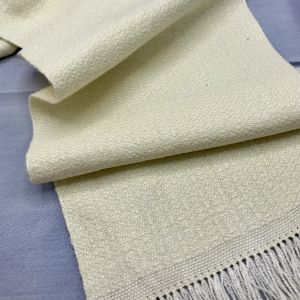
Above: detail of OmShanti Gothic White Cross Scarf; OmShanti-White (warp) and OmShanti-Red (weft), 3/1 Twill tie-up. You can see the warp-dominant side of scarf (bottom of photo) is whiter than the weft dominate side (upper left)
WEAVING WITH OMSHANTI
We introduced our two mill-spun Eri Silk yarns, OmShanti-White and OmShanit-Red, in February 2023. If you missed it, CLICK HERE, as there’s a lot of information that’s helpful background.
In the introduction story, I suggested that using the whiter OmShanti-White and the creamier OmShanti-Red together would make an elegant white-on-white project.
Robin Wilton, a weaver with 40+ years and who has collaborated with Treenway Silks on several weaving projects, was up to the challenge—and here are her gorgeous scarves!
Just in time to weave for Mother’s Day, summer weddings, graduation gifts and evenings out at your favorite restaurant! The understated elegance of white-on-white is classic! Order your 2-scarves kit HERE.
PLANNING THE SCARVES
Warp:
Robin and I decided that while there’s a difference in the white color of OmShanti-White and OmShanti-Red, it would be easier if the warp was all one yarn and the weft all the other.
This was a good decision. You can see the difference between the two OmShanti yarns when they’re in the skein, as the color is “concentrated.” Once you’re working with a single strand, it becomes harder to distinguish between the two different white colors.
Draft:
The next decision was which draft from "A Handweaver's Pattern Book" by Marguerite Porter Davison to select for the scarves. We tossed around a few ideas and “auditioned” a few into PCW Fiberworks weaving software, to get an idea how they would look. We used white for the warp threads (OmShanti-White) and pale yellow for the weft (OmShanti-Red).
We settled on Robin’s favorite “Gothic Cross” from page 41, using treadling II for the first scarf and treadling I for the second scarf. The treadling is actually the same, but the twill tie-up changes from a 2/2 to a 3/1.
Sett:
We discussed what sett to use. Eri silk has a very different feel than bombyx silk, which makes sense as they come from different silk worms.
If we were weaving Gothic Cross with Kiku (20/2 bombyx silk), we would sett at 28 Ends Per Inch (EPI).
However, the Gothic Cross draft is a 24 end repeat, making it easy to thread as 24 EPI, sleying 2-ends per dent in a 12-dent reed.
We debated the merits of “stick with 28 EPI” vs gambling that Eri silk could produce a good cloth at 24 EPI.
We opted to try the 24 EPI, fully aware that a light beat would be necessary.
ROBIN’S WEAVING NOTES:
OmShanti (Eri silk yarn) is “hairier” than Kiku (Bombyx silk yarn), giving OmShanti some wool-like characteristics. But the fuzziness did NOT cause the warp threads to stick together or to pill.
Eri silk has some sheen (although less than Bombyx silk).
Weaving the white-on-white scarves is best with very good light. Mistakes are difficult to see (which also means unweaving to correct is also a bit of a challenge).
The 3/1 twill tie-up, with slightly longer floats, shows the design more than the 2/2 twill tie-up. This is an important consideration when selecting other drafts for white-on-white.
My sett was 24 EPI and I wove at 31 PPI, being very careful to maintain a light beat. Since Gothic Cross design is diamonds (rather than squares), the “not quite square” doesn’t detract from the beauty. If you prefer a more balanced weave, try 28 EPI.
I opted for hem-stitching 4 ends per group (6 ends on each selvage group) and left the fringe hang. You could also do a twisted fringe.
Wet finishing--finger pressing while wet didn’t remove wrinkles, so when damp-dry, I hard-pressed the scarves on a silk setting. This brought up the shine and makes the pattern show better.
After wet finishing, the yarn “fulled” a bit.
Eri silk has a different feel than bombyx silk. Eri silk is very light and airy.
PROJECT STATS:
Draft from A Handweaver's Pattern Book by Marguerite Porter Davison; “Gothic Cross” from page 41.
Loom: 4 shafts / 6 treadles
Project: 2 scarves; each scarf is about 74 inches finished length (including fringe)
Treenway Silks Yarns—1 skein of each:
- OmShanti-White [100% Eri Silk, 20/2], natural white (warp)
- OmShanti-Red [100% Eri Silk, 20/2], natural white (weft)
Sett: 24 EPI [2 per dent in 12 dent reed]
Ends: 195 [193 ends plus 2 floating selvedges]
Warp Length: 5.0 yards for 2 scarves
Warp length planning per scarf: 72 inches woven (measured under tension) + 6 inches fringe on each end + 4 inches for take up in the warp (176 inches for both scarves); plus 4 inches loom waste (above and beyond the fringe at beginning and end of warp). If you require more loom waste, then you can adjust the length of your woven scarf or length of your fringe]
Width in Reed: 8 inches
Picks per Inch: 31
Two Treadling options (same treadling sequence, different tie-ups)
Finished scarves: each is 6.5 inches wide by 75.5” (64.5 inches woven and 5.5 inch fringe on each end).




